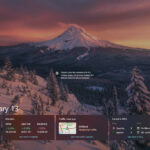The full moon is a captivating celestial event, and capturing its beauty with just your iPhone is absolutely achievable. Whether it’s the ethereal glow of the Snow Moon or any other full moon throughout the year, you can create impressive lunar photographs. Forget complicated camera gear; your smartphone is a powerful tool for moon photography. This guide will provide you with essential techniques and settings to master moon photography with your iPhone, turning you into a lunar photographer in no time.
Essential iPhone Moon Photography Tips
Capturing the moon’s detail with an iPhone requires understanding a few key settings and techniques. It’s about optimizing your iPhone camera’s capabilities and working with the environment to get the best shot. Here are actionable tips to elevate your iPhone moon photos from blurry blobs to crisp, shareable images.
1. Turn Off Flash and Embrace HDR: The Golden Rule
The first and most crucial step is to disable your flash. Your iPhone’s flash is utterly ineffective for illuminating the moon, which is hundreds of thousands of miles away and brightly lit by the sun itself. Using flash will only wash out your image and degrade its quality.
Instead of flash, activate High Dynamic Range (HDR) in your iPhone camera settings. HDR mode intelligently merges multiple exposures to capture a wider range of tones, ensuring both the bright lunar surface and the dark night sky are well-exposed within the same image. This contrast is key to a compelling moon photograph.
2. Master ISO Settings for Lunar Clarity
Lowering the ISO is vital for capturing the moon’s details. ISO measures your camera sensor’s sensitivity to light. For moon photography, you want your camera to be less sensitive to light because the moon is surprisingly bright. An ISO of 100 is an ideal starting point.
On iPhones, accessing ISO control requires a bit of a workaround within the native camera app. Tap the “+” icon above the shutter button. This reveals a set of settings, including exposure. Drag the exposure toggle to the left to reduce the brightness, effectively lowering the ISO and preventing the moon from appearing as an overexposed white disc. This adjustment will bring out the textures and craters on the lunar surface.
3. Understand Shutter Speed for Night Shots
Your iPhone automatically adjusts shutter speed in low-light conditions, often slowing it down to capture more light. While slower shutter speeds are generally used for night photography, the full moon is a bright subject. Experiment with letting your iPhone choose the shutter speed in its automatic night mode, which typically ranges from 3 to 10 seconds.
However, because the moon is well-lit, you might find that a slightly faster shutter speed can result in a sharper image, especially if you are hand-holding your phone (though a tripod is always recommended for maximum sharpness, as discussed later). Experiment with touch-focusing on the moon; sometimes, this can subtly adjust the exposure and shutter speed to be more favorable for lunar detail.
4. Resist the Zoom Temptation: Context is Key
Avoid using digital zoom on your iPhone when photographing the moon. iPhone zoom is digital, not optical, meaning it simply crops and enlarges the existing image, degrading its quality and sharpness. Zooming in digitally will result in a pixelated and disappointing moon photo.
Instead of zooming, embrace the wider perspective. Context is crucial in compelling moon photography. Including the surrounding night sky, landscape, or even silhouetted objects in the foreground adds depth and interest to your image. The contrast between the vastness of the sky and the celestial object enhances the visual impact, making the moon a part of a larger, more captivating scene.
5. Stabilize with a Tripod: Your Best Friend for Sharpness
Using a tripod is highly recommended for sharp moon photos, especially in night photography where even slight movements can cause blur. A tripod eliminates camera shake, allowing you to use slower shutter speeds without sacrificing image clarity.
While hand-holding is possible for quick snapshots, a tripod unlocks the potential for much sharper and more detailed moon images. If you don’t have a tripod, improvise by resting your iPhone against a stable surface like a wall or window ledge to minimize movement while taking the photo. This stability is even more critical when experimenting with slower shutter speeds to capture more detail.
6. Look for a ‘Moon Reflection’ for Creative Shots
Don’t limit yourself to direct shots of the moon. Get creative and seek out moon reflections, particularly on bodies of water. Reflections add an artistic and ethereal dimension to your moon photography. The moments just after moonrise, when the moon is still near the horizon and often appears orange-toned, are ideal for capturing stunning reflections.
If you’re using a tripod, you can also experiment with capturing moonlit landscapes. Full moons cast surprisingly strong light, creating interesting shadows and illuminating environments, especially snowy landscapes which reflect moonlight beautifully. These moonlit scenes, combined with the moon itself, can result in truly unique and captivating photographs.
With these tips, you’re well-equipped to go out and capture the magic of the moon with your iPhone. Experiment with these techniques, find your creative perspective, and enjoy the process of lunar photography. Clear skies and happy shooting!
